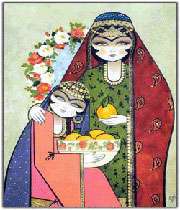NOWRUZ IN THE ISLAMIC PERIOD
(part 7)

Muslim Indian immigrants took Nowruz to South Africa (Iren) and sailors carried it together with the Persian (Zoroastrian-style) calendar to East Africa and to the coasts of the Indian Ocean (Khareghat). The Swahilis have retained much of the Nowruz (vocalized as Nairuzi) ceremonies but adapted them to their beliefs and local rites: a feast is held one week before Nairuzi, then comes fishing and collecting wood in bundles for five days. On the sixth day, another banquet follows, the Quran is recited, and on the next day people go to the beach, bathe, put on new clothes, sing and dance. After a ceremonial meal all fires are extinguished and later rekindled by the primitive method of fire sticks (for details see Gray; Freeman-Grenville). In recent years Nowruz has again come in favor in Turkey. On 21-23 March 2000 a symposium was held in Ankara for studying the observance of Nowruz in the Turkic-language regions, and the papers were published in Uluslararasi Nevruz Sempozyumu bildirileri: 21-23 Mart 2000, Ankara (see bibliography). They demonstrate the wide spread of Nowruz celebrations and joyous songs associated with it among the peoples speaking Turkic languages: the Nachchevanis, Turkmens, peoples of Sivas, Afyonkarahisa, northern Caucasus and Central Asia, the Alavid Bektashis of Anatolia, the Kazakhs, Uzbeks, Kyrgyz, and the Altay Turks. Also there are useful accounts of the Nowruz-related folklore and plant symbolism in Anatolia, and on practices common to various groups. They contain solid data which demonstrate the wide spread observation of the Nowruz. Most recently, Iranian communities abroad have popularized Nowruz and sizdah bedar far beyond the borders of Persia and the sphere of Persian culture.
Source: iranica
Other Links:
Persian Cuisine, a Brief History (part 2)
Iranian Girl Names (part 2)
Iranian Girl Names (part 3)
Astrology & Astronomy in Iran and Ancient Mesopotamia (part 2)
Astrology & Astronomy in Iran and Ancient Mesopotamia (part 3)